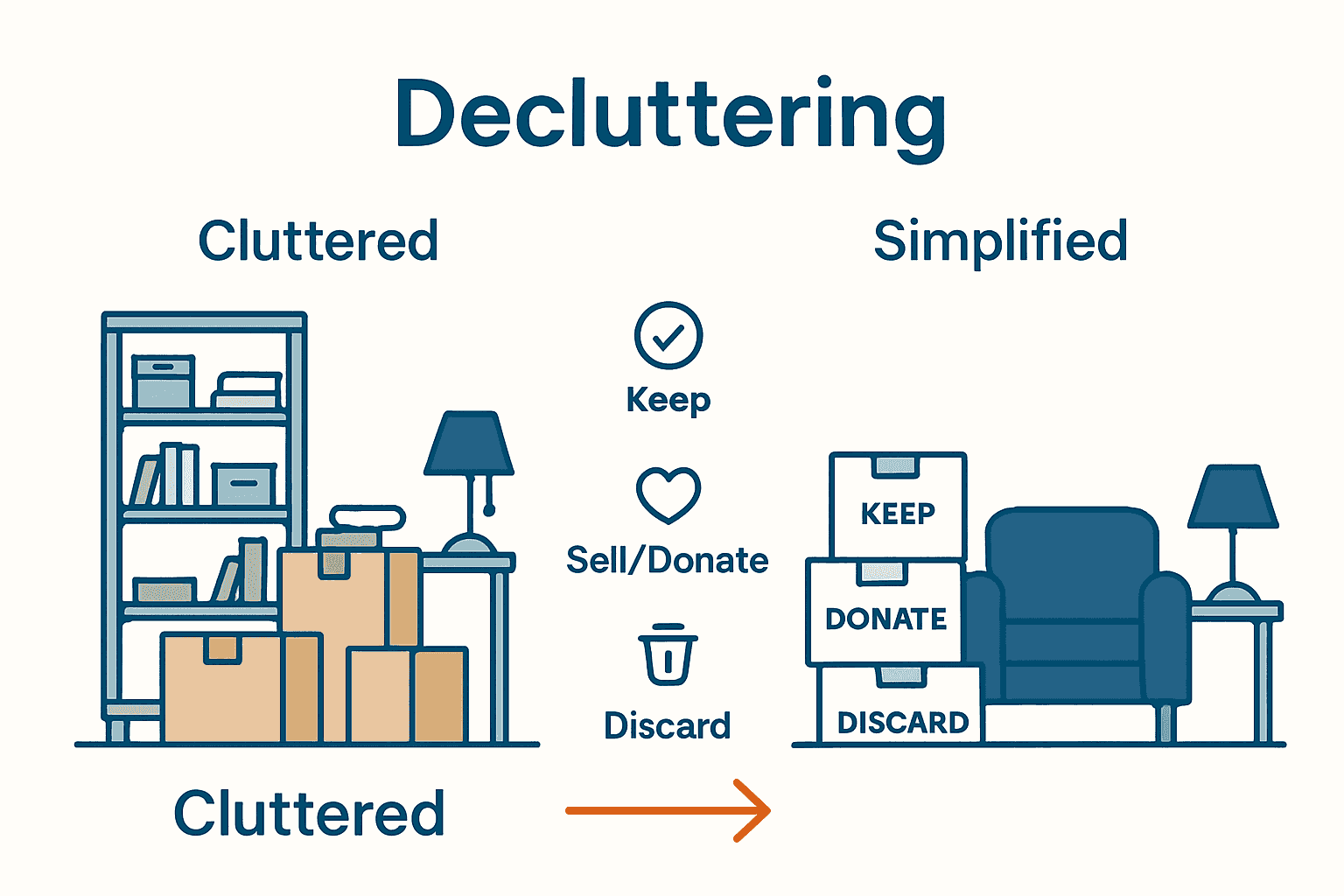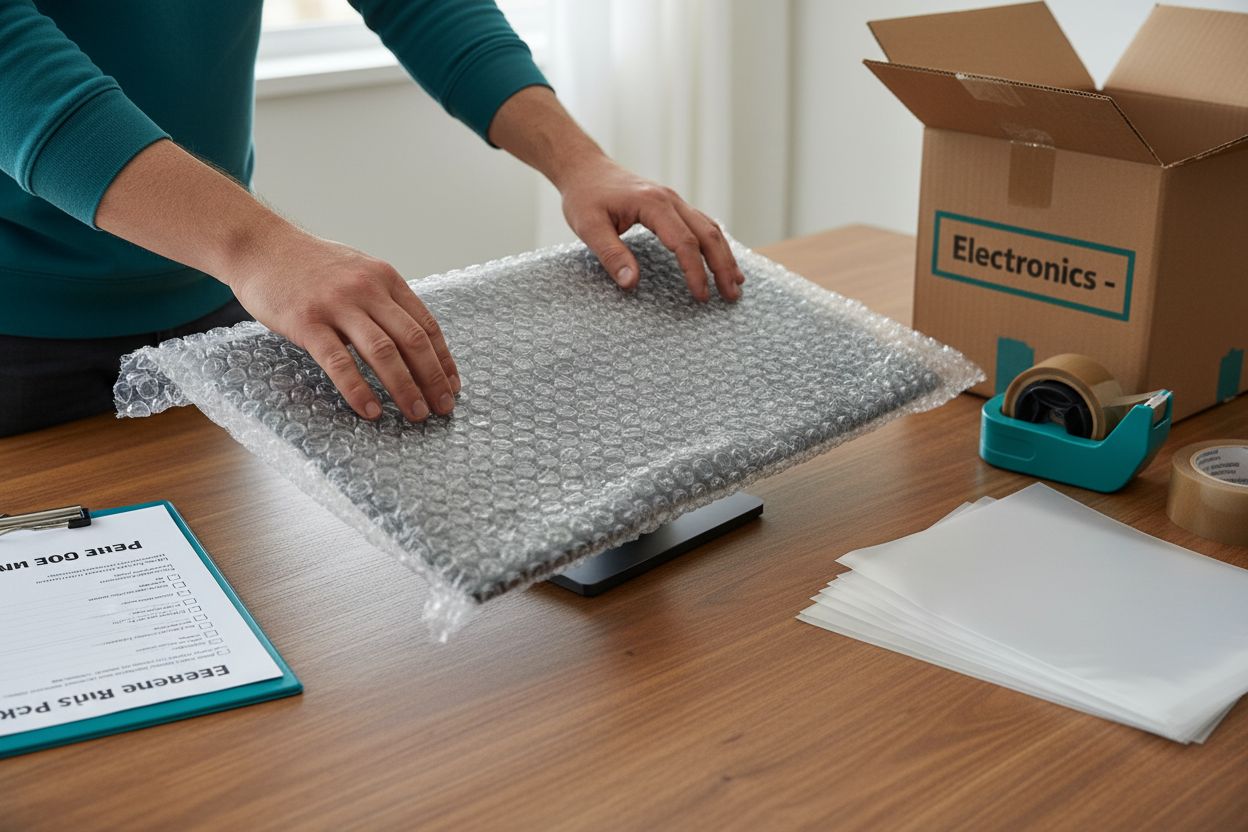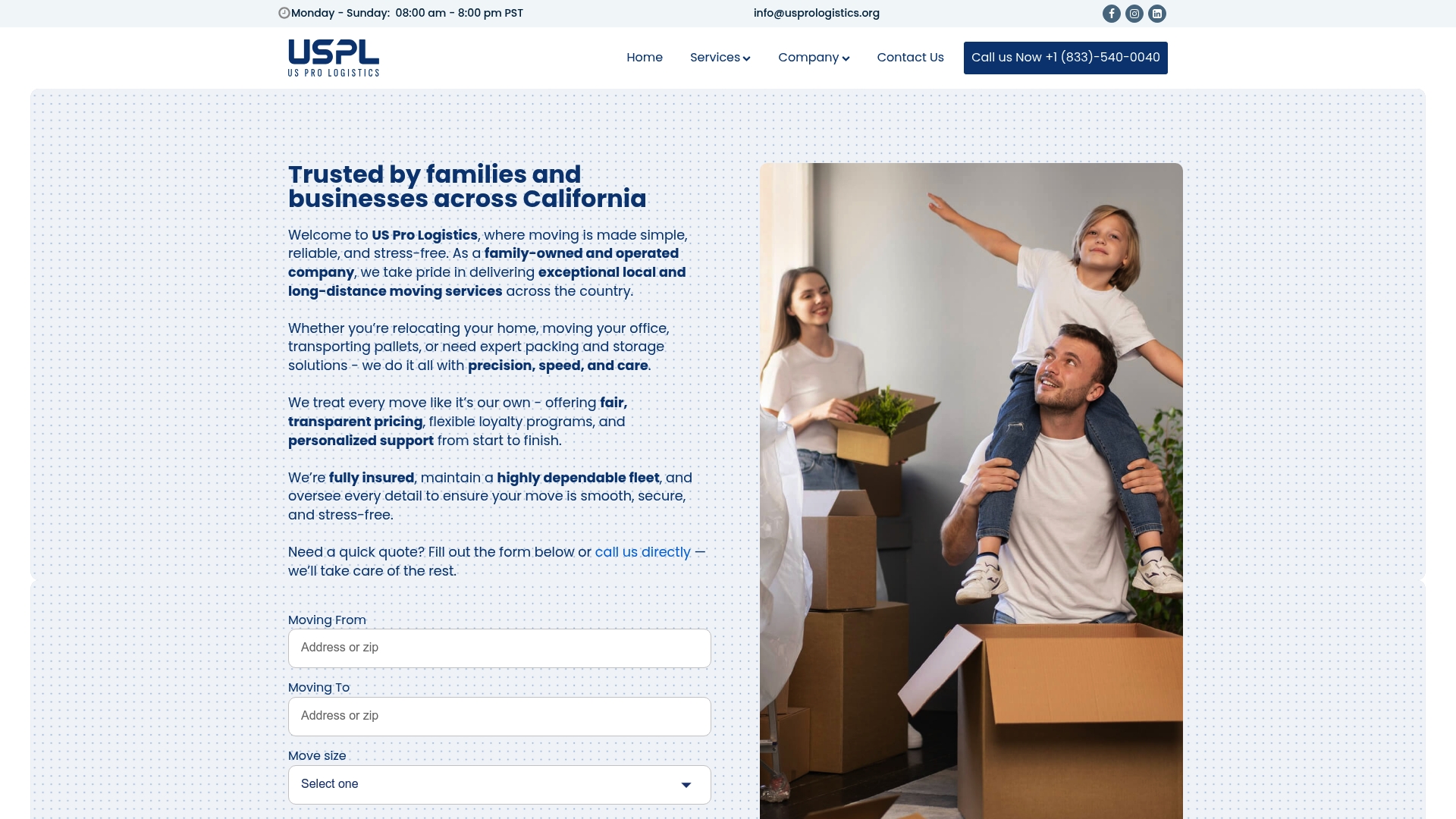
Preparing to downsize before a move sounds simple at first—just sort your stuff and pack, right? Yet when you realize that the average American home contains over 300,000 items, the idea of an easy move suddenly feels impossible. What most people miss is that downsizing successfully is less about getting rid of things and more about setting up a smoother, less stressful new beginning.
| Key Point | Explanation |
|---|---|
| 1. Assess belongings thoughtfully | Evaluate each item based on utility, purpose, and emotional value to make better downsizing decisions. |
| 2. Set detailed downsizing goals | Define specific, measurable objectives that reflect your moving motivations and guide your downsizing process effectively. |
| 3. Sort items into four categories | Create clear paths for belongings by categorizing them into keep, sell, donate, and discard for easier management. |
| 4. Organize sales or donation events | Plan effective sale or donation events to maximize value from items while minimizing logistical challenges. |
| 5. Perform a thorough pre-move check | Verify all belongings and arrangements are in order to ensure nothing important is overlooked before the move. |
Downsizing before moving is more than just packing boxes—it’s a strategic process of evaluating what truly matters in your life. When you begin to assess your current belongings, you’re essentially creating a roadmap for a more streamlined, intentional move. This crucial first step helps you understand the volume of items you own and make informed decisions about what will accompany you to your new space.
Start by systematically walking through each room in your current living space. As you move, create three distinct mental categories: keep, donate, and discard. This approach transforms the overwhelming task of sorting through years of accumulated possessions into a manageable, almost therapeutic experience. Pay special attention to items with emotional significance, understanding that memories reside in your heart, not exclusively in physical objects.
Key Evaluation Criteria for Your Belongings:
Utilize this assessment phase to be brutally honest with yourself. Many people hold onto items out of habit or sentiment, not genuine utility. A practical strategy is to create a staging area—perhaps a spare room or section of your garage—where you can lay out items and make deliberate, unemotional decisions. Digital tools can assist in this process, with apps that help catalog and track your belongings during the downsizing journey.
Remember that successful downsizing isn’t about getting rid of everything, but about curating a collection of possessions that genuinely enhance your life. By the end of this step, you should have a clear inventory of what will make the move with you, what can find new life through donation, and what has reached the end of its useful journey. Check out our comprehensive moving preparation guide for additional insights into creating a smooth transition to your new home.
After assessing your belongings, the next critical step in how to downsize before moving is establishing precise, actionable goals that transform your vision into a structured plan. Goal setting isn’t just about deciding what to keep or discard—it’s about understanding the deeper motivations behind your move and creating a strategic framework that guides your entire downsizing process.
Begin by defining your primary objectives. Are you moving to a smaller space, reducing living expenses, or preparing for a significant lifestyle transition? Your goals will significantly influence how aggressively you approach downsizing. For instance, someone moving from a four-bedroom house to a compact urban apartment will need a more rigorous reduction strategy compared to someone relocating to a similarly sized home.
Quantifiable Downsizing Goals Might Include:
Consider creating a detailed timeline that breaks down your downsizing journey into manageable phases. This approach prevents overwhelm and provides clear milestones to track your progress. A typical timeline might allocate specific weeks for different areas of your home—perhaps starting with less emotionally charged spaces like the garage or home office, then progressing to more personal areas like bedrooms and living rooms.
Financial considerations should also factor into your goal setting. Calculate the potential cost savings from reduced moving expenses, lower storage needs, and potentially smaller living spaces. Some individuals discover that effective downsizing can translate into significant economic benefits beyond the immediate moving process.
The most successful downsizing efforts blend emotional intelligence with practical strategy. Be compassionate with yourself during this process, recognizing that letting go of possessions can be challenging. Your goals should reflect not just what you’re releasing, but what you’re gaining—more freedom, reduced stress, and a more intentional lifestyle. Learn more about effective moving strategies to support your downsizing journey and ensure a smooth transition to your new living space.
Sorting your belongings into distinct categories transforms the abstract concept of downsizing into a tangible, actionable process. This critical step requires a blend of emotional detachment and strategic decision making. Think of this sorting stage as creating four distinct pathways for your possessions—each item will find its appropriate destination, ultimately simplifying your moving experience and potentially benefiting others.
Sorting Strategy Fundamentals:
Establish a dedicated sorting area where you can spread out items and make deliberate choices. Use sturdy boxes or marked zones for each category: keep, sell, donate, and discard. The keep category should contain items that are functionally necessary, deeply meaningful, or impossible to replace. For sell-worthy items, consider their potential market value and condition. Electronics, furniture in good shape, and collectibles often fetch reasonable prices through online platforms or local resale shops.
Donation offers a powerful opportunity to give items a second life while potentially receiving tax benefits. Prioritize items that are clean, functional, and in good condition. Local charities, shelters, and community centers frequently welcome clothing, kitchenware, books, and furniture. For items that are damaged or worn beyond practical use, responsible disposal becomes crucial. Research local recycling guidelines and waste management protocols to ensure environmentally conscious discarding.
Emotional attachment can complicate sorting, so develop a systematic approach. One effective method involves asking yourself targeted questions: Have I used this in the past year? Does this item align with my current lifestyle? Would I buy this again today? These questions help create emotional distance and facilitate more rational decision-making.
Remember that sorting is an iterative process. Your initial pass might feel challenging, but subsequent reviews often become easier as you gain confidence in your downsizing strategy. Explore our comprehensive moving preparation resources for additional guidance on streamlining your relocation journey. By the end of this step, you should have clear, separated categories that represent a thoughtful, intentional approach to reducing your belongings.

Transitioning from sorting to actual distribution requires strategic planning and execution. An organized sale or donation event can transform the potentially stressful process of downsizing into an efficient, even enjoyable experience. This step is about maximizing the value of your items while minimizing the logistical complexity of removing them from your living space.
For those pursuing a selling strategy, multiple platforms offer distinct advantages. Online marketplaces like Facebook Marketplace, Craigslist, and specialized apps provide broad reach with minimal effort. Alternatively, a traditional neighborhood garage sale can quickly clear out multiple items while potentially creating a community engagement opportunity. Price items reasonably—typically at 10-30% of their original value—to encourage swift sales and prevent items from becoming unsold inventory.
Effective Sales and Donation Preparation Checklist:
Donation requires equally thoughtful preparation. Many charitable organizations have specific guidelines about acceptable item conditions. Goodwill, local shelters, and community centers often welcome clothing, furniture, and household goods in good, clean condition. Some organizations offer pickup services, which can significantly simplify your donation process. When donating, request receipts for potential tax deductions, transforming your generosity into a potential financial benefit.
Timing is crucial in this phase. Schedule your sale or donation event strategically, allowing sufficient preparation time while maintaining momentum from your earlier sorting efforts. Weekend mornings typically attract the most potential buyers or donors. Consider coordinating with neighbors for a multi-household event, which can attract more traffic and create a more festive atmosphere.
Remember that not everything will sell or be donated immediately. Have a backup plan for remaining items, such as scheduling additional online listings or contacting specialty donation centers. Explore our comprehensive moving preparation guide for additional strategies in managing your downsizing journey effectively. By the conclusion of this step, you should have significantly reduced your belongings and potentially generated some additional funds or charitable contributions.
With your downsizing efforts complete, the next crucial phase is preparing and packing your carefully curated collection of remaining belongings. This step transforms your strategic decisions into practical action, requiring methodical approach and attention to detail. Your goal is to protect your items during transit while creating an organized system that will simplify unpacking at your new location.
Essential Packing Preparation Checklist:
Start by collecting sturdy packing supplies—invest in quality boxes, bubble wrap, packing paper, and strong packing tape. Group items by room and fragility, creating a systematic approach that prevents potential damage. Heavier items should be placed in smaller boxes to maintain manageable weight, while lighter items can fill larger containers. Fragile items require extra care, using generous amounts of cushioning material and marking boxes with clear “FRAGILE” indicators.
Consider the unique requirements of specific item categories. Electronics demand specialized packing techniques to prevent damage during transportation. Wrap screens and delicate components individually, using anti-static bubble wrap when possible. For clothing, vacuum-sealed bags can dramatically reduce volume and protect fabrics from moisture and potential transit damage.
Documentation becomes crucial during this phase. Create a comprehensive inventory listing the contents of each box, including a numbered or color-coded system for easy tracking. Photograph valuable or sentimental items before packing as an additional precaution. This approach not only helps with potential insurance claims but provides peace of mind during the moving process.

Mental preparation is equally important as physical packing. Approach this step with patience and deliberation, understanding that careful preparation now prevents stress and potential item loss later. By the conclusion of this step, you should have a well-organized, carefully packed collection of belongings ready for their next journey. Our comprehensive moving preparation resources can provide additional guidance to ensure a smooth transition.
The final verification stage is your critical safeguard against potential moving day oversights. This comprehensive review transforms your meticulous preparation into a foolproof moving strategy, ensuring nothing essential slips through the cracks. Think of this step as your personal moving insurance policy, a methodical approach to confirming you’ve accounted for every critical aspect of your relocation.
Essential Pre-Move Verification Checklist:
Begin by cross-referencing your detailed inventory against the packed boxes. Walk through each room systematically, comparing your initial sorting lists with the current state of your belongings. Pay special attention to easily overlooked spaces like closet tops, garage shelves, and under-bed storage. Important documents deserve extra scrutiny—gather and secure birth certificates, passports, medical records, and financial paperwork in a dedicated, easily accessible folder.
Logistical verification extends beyond physical items. Confirm all utility transfers, change of address notifications, and service disconnections are scheduled precisely. Contact your moving company to review final details, confirming pickup times, delivery windows, and any specific transportation requirements for special items. Create a digital and physical backup of critical contact information, including moving company representatives, utility providers, and emergency contacts.
Prepare a personal essentials kit that travels with you directly. This should include medications, immediate clothing needs, chargers, important documents, and a few days’ worth of personal care items. This preparation ensures you’re not scrambling if there’s a delay in your belongings’ arrival. Consider the potential scenarios—what would you need if your moving truck were delayed by a day or two?
Mental preparation is as crucial as physical readiness. Take a moment to breathe and acknowledge the significant work you’ve accomplished in downsizing and preparing for this transition. Our comprehensive moving resources can provide additional last-minute guidance to ensure a smooth move. By the end of this verification process, you should feel confident, organized, and prepared for your upcoming relocation adventure.
Sorting through years of belongings and letting go of what you no longer need is never easy. Our article highlighted the overwhelmed feeling that comes with making tough decisions about what to keep, sell, donate, or discard. Maybe you are anxious about protecting sentimental items, uncertain about logistics, or worried about packing and transporting what truly matters. Downsizing can be emotional, but you do not have to do it alone. The process of turning your assessment, goal setting, and careful packing into a successful move calls for professional support you can trust.

Let US Pro Logistics simplify every step of your transition. We have experience helping individuals, families, and businesses across California and the United States move with confidence—no matter how complex your downsizing needs may be. Our team offers safe packing, secure storage, and transparent communication, ensuring you keep what you love and part with the rest, stress-free. Visit our Moving Preparation Resources for more practical downsizing tips or start your journey with US Pro Logistics to get your free quote today. Take the smart step right now toward a lighter, more organized move.
Begin your downsizing process by assessing your current belongings. Walk through each room, and categorize items into keep, donate, and discard to create a clear roadmap for your move.
Set clear, actionable downsizing goals that align with your moving objectives. For example, aim to reduce your total belongings by 30–50% to create a more manageable living environment.
Sort your items by creating four categories: keep, sell, donate, and discard. Use a dedicated sorting area to physically separate these groups, making it easier to decide the fate of each item.
When organizing a sale or donation event, prepare thoroughly by cleaning items, taking clear photographs, and setting reasonable prices. Aim for a weekend morning for your sale to attract more buyers, or contact local charities for donation pickups.
Pack your remaining items carefully by using high-quality boxes and labeling each container comprehensively. Ensure fragile items are well-cushioned, and create a detailed inventory to keep track of everything.
Before moving day, verify your comprehensive inventory, check that all utility transfers are scheduled, and prepare a personal essentials kit. This final step helps ensure nothing critical is overlooked and that you are fully prepared for the move.
Below is a checklist table summarizing key verification tasks to complete before moving day, making it easy to ensure nothing important is missed.
| Verification Task | What to Do | Why It Matters |
|---|---|---|
| Review inventory | Cross-check all packed boxes against your inventory list | Prevents losing or forgetting items |
| Check personal documents | Gather passports, certificates, financial records | Ensures access to critical documents |
| Confirm utility transfers | Validate start/end dates for electricity, water, internet | Maintains service continuity |
| Validate moving logistics | Contact movers to confirm times and special requirements | Avoids last-minute logistical issues |
| Prepare essentials kit | Pack medications, clothes, chargers, and toiletries | Ensures necessities are within reach |
USDOT 3664256 This number is required for any company that operates commercial vehicles in interstate commerce (across state lines). It helps identify and track the safety performance and compliance of transportation companies.
MC 1268070 This number is specifically for companies involved in the transportation of goods or passengers for hire across state lines. It’s necessary for carriers operating in the moving industry and ensures they are authorized to operate as interstate carriers.